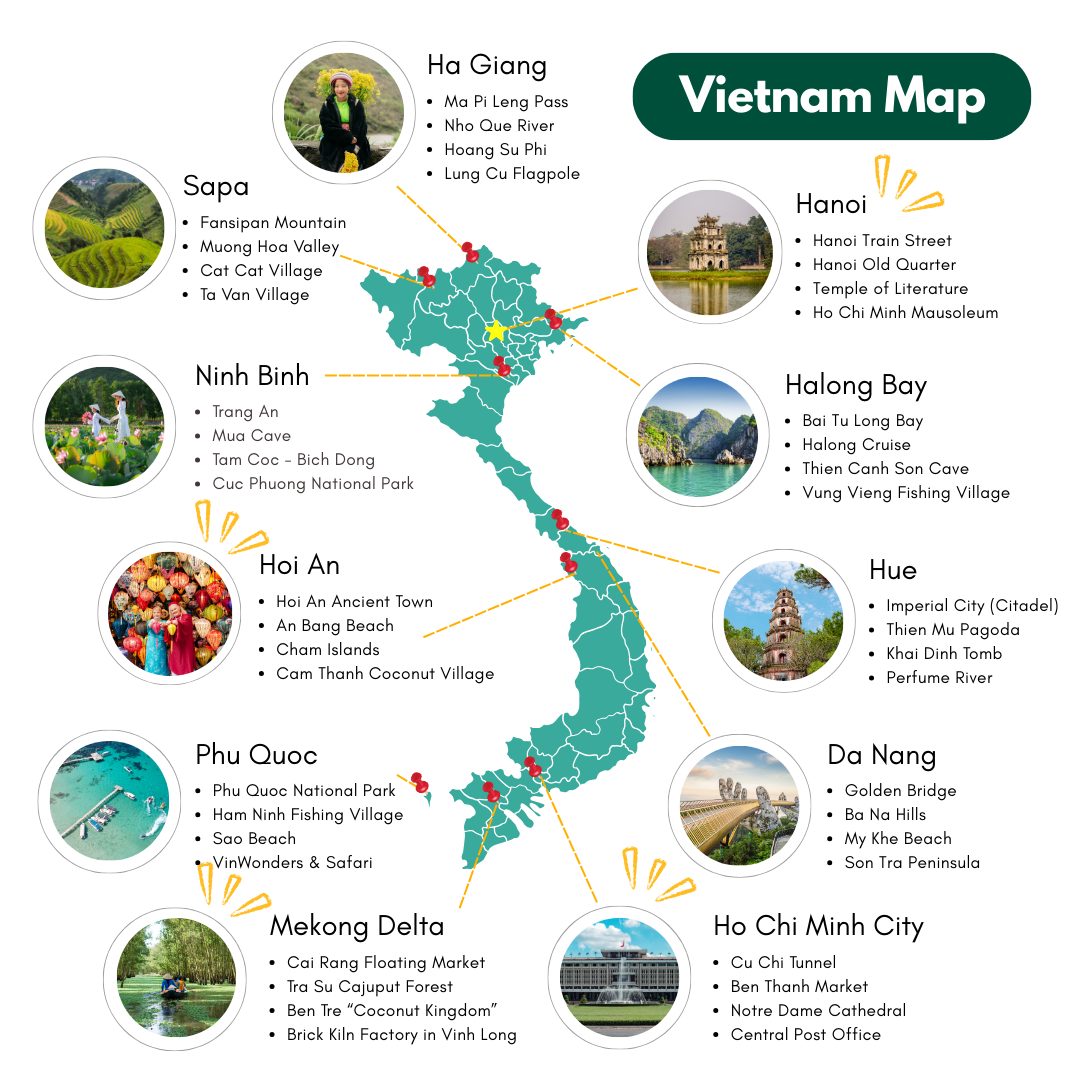MENU
- 1 🗺️ Overview: Why You Need a Vietnam Travel Map
- 2 📍 Main Travel Regions of Vietnam
- 3 🚗 How to Travel Across Vietnam
- 4 🧭 Suggested Vietnam Travel Routes
- 5 🗓️ Best Time to Visit Vietnam
- 6 📍 Useful Tips for First-Time Visitors
- 6.1 💬 1. Learn a Few Local Phrases
- 6.2 💵 2. Always Carry Cash
- 6.3 🚗 3. Choose Reliable Transportation
- 6.4 📱 4. Get a Local SIM or eSIM
- 6.5 🍜 5. Try Street Food — But Eat Smart
- 6.6 🧭 6. Download Offline Maps
- 6.7 ⏰ 7. Plan Around Local Holidays
- 6.8 🎒 8. Dress Modestly for Temples
- 6.9 🪙 9. Tipping Is Not Mandatory — But Appreciated
- 6.10 🧡 10. Stay Open-Minded and Respect Local Customs
- 7 🌐 Download or Save Your Vietnam Travel Map
- 8 ❓ Frequently Asked Questions (FAQ)
- 9 🎯 Conclusion
🗺️ Overview: Why You Need a Vietnam Travel Map
Vietnam is a country of incredible contrasts — stretching over 1,600 kilometers from the misty mountains of the north to the tropical beaches of the south. With so many destinations, routes, and experiences to choose from, having a Vietnam travel map is essential for any traveler who wants to explore efficiently and meaningfully.
A detailed travel map helps you visualize your journey, understand regional distances, and plan the most convenient route between must-see attractions like Ha Long Bay, Hue Imperial City, Hoi An Ancient Town, and Ho Chi Minh City.
Whether you’re backpacking along the coast, flying between major cities, or booking a private car service for scenic day trips, a travel map makes it easier to:
-
Identify key cities and landmarks along your route
-
Choose the best travel method (flight, train, or private car)
-
Estimate travel time and costs between destinations
-
Discover hidden gems between popular stops
In short, your Vietnam adventure starts with the map — it’s not just about where you’re going, but how you connect every unforgettable place in between.

📍 Main Travel Regions of Vietnam
Vietnam is traditionally divided into three major regions — North, Central, and South — each offering its own culture, cuisine, and breathtaking landscapes. Understanding these regions helps you plan an itinerary that captures the country’s full beauty from mountains to beaches.
🌄 Northern Vietnam – Culture & Nature
Northern Vietnam is rich in history, culture, and scenic beauty.
-
Hanoi: The lively capital city with French colonial architecture, lakes, and delicious street food.
-
Ha Long Bay: A UNESCO World Heritage Site famous for emerald waters and towering limestone islands.
-
Ninh Binh: Known as “Ha Long Bay on land”, perfect for boat trips through rice paddies and caves.
-
Sapa: A mountain retreat with terraced rice fields and ethnic minority villages — ideal for trekking.
🧭 Best travel season: October to April (cool and dry weather)

🏯 Central Vietnam – Heritage & Beaches
Central Vietnam blends royal history with stunning coastal scenery.
-
Hue: The ancient imperial capital with its citadel, royal tombs, and Perfume River.
-
Da Nang: A modern, fast-growing city known for My Khe Beach and easy access to Ba Na Hills and Son Tra Peninsula.
-
Hoi An: A UNESCO-listed old town glowing with lanterns, tailor shops, and riverside cafes.
-
Phong Nha: Adventure seekers’ paradise with record-breaking caves like Son Doong and Paradise Cave.
🧭 Best travel season: February to August (sunny, beach-perfect weather)

🌴 Southern Vietnam – Energy & Islands
Southern Vietnam offers a vibrant mix of city life and tropical relaxation.
-
Ho Chi Minh City (Saigon): A dynamic metropolis blending French charm with modern energy.
-
Mekong Delta: Known for its floating markets, boat rides, and authentic countryside life.
-
Phu Quoc Island: Vietnam’s beach paradise — white sands, coral reefs, and luxury resorts.
🧭 Best travel season: December to April (dry and sunny)

✨ Each region tells a different story — from ancient temples and mountain villages in the north to imperial cities and coastal resorts in the center, and finally to the modern skyline and tropical islands of the south.
To experience it all comfortably, consider booking a private car with driver via Danang Transfer for a smooth, flexible journey across Vietnam.
🚗 How to Travel Across Vietnam
Getting around Vietnam is easier than ever thanks to its growing transportation network of domestic flights, trains, buses, and private cars. The best option depends on your budget, schedule, and travel style — whether you prefer speed, comfort, or scenic routes.
Below is a complete comparison of the most popular travel methods across the country:
| Transport Option | Duration | Best For | Highlights & Notes |
|---|---|---|---|
| ✈️ Domestic Flights | 1–2 hours | Long distances | Quickest way to travel between north (Hanoi), center (Da Nang), and south (Ho Chi Minh City). Carriers: Vietnam Airlines, VietJet Air, Bamboo Airways. |
| 🚆 Reunification Express Train | 30–35 hours (Hanoi–HCMC) | Scenic & cultural experience | Famous coastal route offering views of beaches, villages, and mountains. Comfortable soft beds available. |
| 🚌 Tourist Bus / Minivan | 4–8 hours (short routes) | Budget travelers | Ideal for intercity trips like Da Nang–Hue or Hoi An–Nha Trang. Affordable but can be crowded. |
| 🚙 Private Car with Driver | Flexible | Comfort, privacy & sightseeing | Perfect for families and groups. You can stop at attractions anytime. Available nationwide via Danang Transfer. |
| 🏍️ Motorbike / Scooter | Custom | Adventure seekers | The best way to explore local roads, but requires confidence and safety gear. |
| 🚢 Cruise or Ferry | Varies | Island & coastal trips | Great for Halong Bay, Mekong Delta, and Phu Quoc Island routes. |

💡 Travel Tips for Getting Around Vietnam
-
Combine transport types for efficiency — e.g., fly between cities, then use a private car for day trips.
-
Book domestic flights early, especially during holidays like Tet (Vietnamese New Year).
-
Avoid overnight buses unless you’re comfortable with tight sleeping berths.
-
Download offline maps (Google Maps or Maps.me) for navigation in remote areas.
-
For smooth, door-to-door service, book a private transfer via Danang Transfer — trusted by thousands of international travelers.

Vietnam offers something for everyone — from budget backpackers to luxury explorers. Whether you’re chasing waterfalls in the north, royal palaces in Hue, or golden beaches in Da Nang, choosing the right mode of transportation ensures a smooth and memorable journey.
🔗 Book your reliable private car anywhere in Vietnam with Danang Transfer.
🧭 Suggested Vietnam Travel Routes
Vietnam is long and narrow — stretching from Hanoi in the north to Ho Chi Minh City in the south — which makes route planning essential. Whether you have one week or a whole month, the right itinerary helps you experience Vietnam’s diverse landscapes, from ancient temples to golden beaches.
Below are some of the most popular and practical Vietnam travel routes recommended for first-time visitors.
🌏 1. Classic North–Central–South Route (10–14 Days)
Hanoi → Ninh Binh → Ha Long Bay → Da Nang → Hoi An → Hue → Ho Chi Minh City
🚌 Best for: First-time travelers who want to see Vietnam’s highlights in one trip.
✨ Highlights:
-
Explore Hanoi’s Old Quarter and Hoan Kiem Lake
-
Cruise overnight in Ha Long Bay
-
Visit Ba Na Hills and the Golden Bridge in Da Nang
-
Wander through Hoi An’s ancient lantern town
-
Discover imperial Hue before flying to vibrant Ho Chi Minh City
🔗 Tip: Use domestic flights between Hanoi, Da Nang, and Ho Chi Minh for speed — and book private cars for day tours via Danang Transfer.

🏖️ 2. Vietnam Beach Lovers Route (7–12 Days)
Da Nang → Hoi An → Quy Nhon → Nha Trang → Phu Quoc
🧳 Best for: Sunseekers and families looking for relaxing coastal holidays.
🌅 Highlights:
-
Swim at My Khe Beach in Da Nang
-
Watch lanterns on the Thu Bon River in Hoi An
-
Discover hidden coves in Quy Nhon
-
Dive and island-hop in Nha Trang
-
Finish with tropical sunsets in Phu Quoc
💡 Best time: February to August for sunny, dry weather across the central coast.

🏯 3. Vietnam Heritage & Culture Route (8–10 Days)
Hue → Hoi An → My Son Sanctuary → Da Nang City Tour
🎭 Best for: History lovers and photographers.
🏰 Highlights:
-
Explore Hue’s Imperial Citadel and royal tombs
-
Visit ancient temples in My Son (UNESCO Site)
-
Wander through lantern-lit streets of Hoi An
-
Ride along Da Nang’s scenic coastal roads to Son Tra Peninsula
🚗 Travel tip: A private car with driver is ideal for this route — you can stop for photos, local food, or beach breaks anytime.

⛰️ 4. Northern Adventure Route (6–9 Days)
Hanoi → Sapa → Ha Giang Loop → Ninh Binh
🏕️ Best for: Nature and adventure travelers.
🌄 Highlights:
-
Trek through Sapa’s rice terraces
-
Experience Ha Giang’s epic mountain passes
-
Take a peaceful boat trip in Ninh Binh’s Tam Coc
-
Return to Hanoi for local coffee and culture

🚙 5. Central Vietnam Highlights (4–6 Days)
Da Nang → Ba Na Hills → Hoi An → Hue
🧭 Best for: Short vacations or cruise passengers at Chan May Port or Tien Sa Port.
🌟 Highlights:
-
Visit the Golden Bridge and French Village in Ba Na Hills
-
Enjoy Hoi An’s night market
-
Cross Hai Van Pass — one of Asia’s most scenic drives
-
Explore Hue’s royal history before heading back to Da Nang
✨ Book directly with Danang Transfer for port pick-ups, day tours, and multi-day transfers across Central Vietnam.
No matter which route you choose, Vietnam’s travel map connects a world of experiences — from misty mountains and imperial cities to white-sand beaches and floating markets.

🚗 To make your trip seamless and comfortable, book your private car with English-speaking driver at
👉 Danang Transfer – Vietnam Private Car Service
🗓️ Best Time to Visit Vietnam
Vietnam’s weather varies greatly from north to south, which means you can travel here almost any time of the year — as long as you plan the right region for the season. The country has three distinct climate zones, and understanding them will help you design the perfect itinerary.
🌄 Northern Vietnam (Hanoi, Ninh Binh, Sapa, Ha Long Bay)
-
Best months: October → April
-
Weather: Cool, dry, and ideal for sightseeing or trekking.
-
Highlights: Enjoy clear skies in Ha Long Bay, comfortable hiking in Sapa, and spring festivals in Hanoi.
-
Avoid: July–September when tropical storms may affect the north coast.

🏯 Central Vietnam (Hue, Da Nang, Hoi An, Phong Nha)
-
Best months: February → August
-
Weather: Warm and sunny — perfect for beach lovers.
-
Highlights: Golden Bridge at Ba Na Hills, beach days in Da Nang, and lantern festivals in Hoi An.
-
Avoid: October–December when short rainstorms or typhoons can occur.
💡 Tip: Central Vietnam enjoys sunshine even when the north or south has rain — making it a great “all-year” destination.

🌴 Southern Vietnam (Ho Chi Minh City, Mekong Delta, Phu Quoc)
-
Best months: December → April
-
Weather: Dry and sunny, perfect for outdoor adventures and island escapes.
-
Highlights: Explore the Mekong Delta’s floating markets, relax on Phu Quoc beaches, and enjoy Saigon nightlife.
-
Avoid: May–November (rainy season), though showers are usually short and refreshing.

☀️ Quick Weather Overview by Region
| Region | Dry Season | Rainy Season | Best For |
|---|---|---|---|
| 🌄 North | Oct – Apr | May – Sep | Culture, trekking, sightseeing |
| 🏯 Central | Feb – Aug | Sep – Jan | Beaches, heritage sites |
| 🌴 South | Dec – Apr | May – Nov | Islands, city life, river tours |
🎒 Extra Travel Tips
-
Check local holidays such as Tet (Vietnamese New Year, Jan–Feb) when transportation and hotels book out early.
-
Bring light clothes, sunscreen, and a hat for most of the year.
-
Always carry a light raincoat during the monsoon months.
-
Combine different regions to balance weather conditions — for example, Central Vietnam during rainy seasons elsewhere.
There’s truly no bad time to visit Vietnam — only better times for certain regions.
If you plan smartly, you can enjoy sunshine, culture, and comfort all year round.
🚗 To make your trip effortless and comfortable, book your private car with driver via
👉 Danang Transfer – Vietnam Private Car Service
📍 Useful Tips for First-Time Visitors
Visiting Vietnam for the first time is an unforgettable adventure — but a little preparation can make your trip even smoother. From navigating local transport to understanding customs and payment methods, here are the most useful Vietnam travel tips every traveler should know.
💬 1. Learn a Few Local Phrases
A friendly “Xin chào” (hello) or “Cảm ơn” (thank you) goes a long way!
Even basic Vietnamese words show respect and instantly make locals smile.
🗣️ Tip: Download Google Translate offline for quick help with menus and directions.
💵 2. Always Carry Cash
Vietnam is still largely a cash-based economy.
While cards are accepted in hotels and large restaurants, small shops, taxis, and local markets prefer Vietnamese Dong (₫).
💡 Tip: Withdraw from ATMs in cities like Hanoi, Da Nang, and Ho Chi Minh City to avoid currency scams.
🚗 3. Choose Reliable Transportation
Avoid unregistered taxis or random motorbikes on the street.
For safety and comfort, use reputable transfer services such as
👉 Danang Transfer for private cars, airport transfers, and day trips across Vietnam.
🧳 Private cars with drivers are ideal for flexible sightseeing and families traveling with luggage.
📱 4. Get a Local SIM or eSIM
Stay connected with 4G everywhere.
You can buy a SIM card at the airport or use eSIMs from Viettel or Mobifone for convenience.
🔗 Tip: Having mobile data helps with maps, ride-hailing apps, and translations.
🍜 5. Try Street Food — But Eat Smart
Street food is a highlight of Vietnam!
From Bánh mì to Phở and fresh spring rolls, local stalls offer amazing flavors at low prices.
✅ Choose busy stalls (high turnover = fresh food) and avoid raw vegetables if you have a sensitive stomach.
🧭 6. Download Offline Maps
Install Google Maps or Maps.me before your trip.
They’re extremely useful in rural areas like Ninh Binh, Ha Giang, or the Mekong Delta where data coverage may be weak.
⏰ 7. Plan Around Local Holidays
The Tet Holiday (Vietnamese Lunar New Year) usually falls between late January and mid-February.
During this time, many local businesses close, and transport tickets sell out fast — book early if you’re traveling then.
🎒 8. Dress Modestly for Temples
When visiting pagodas or spiritual sites, cover your shoulders and knees.
This small gesture of respect is deeply appreciated in Vietnamese culture.
🪙 9. Tipping Is Not Mandatory — But Appreciated
Tipping isn’t expected, but it’s a nice way to thank drivers, hotel staff, or guides for great service.
A small amount (20,000₫–50,000₫) is often enough.
🧡 10. Stay Open-Minded and Respect Local Customs
Vietnamese people are warm, polite, and proud of their culture.
Smile often, be patient with language differences, and you’ll receive kindness everywhere you go.

🌐 Download or Save Your Vietnam Travel Map
You can view and save a high-quality Vietnam route map featuring:
✅ Airports and main highways
✅ Top attractions by region
✅ Recommended travel routes
👉 Download Vietnam Travel Map (HD)
❓ Frequently Asked Questions (FAQ)
1. How many days do you need to travel across Vietnam?
Most travelers spend 10 to 14 days exploring Vietnam from north to south.
If you have less time, you can focus on one region — for example, Hanoi, Ha Long Bay, and Ninh Binh in the north, or Da Nang, Hoi An, and Hue in the center.
2. What is the best way to travel around Vietnam?
The best way depends on your schedule and comfort level:
-
Domestic flights are ideal for long distances (Hanoi ↔ Ho Chi Minh City).
-
Private car with driver is perfect for sightseeing and day trips.
-
Trains and buses are good for budget travel and local experiences.
🚗 Book a reliable private car in Vietnam for comfort and flexibility.
3. When is the best time to visit Vietnam?
-
North: October–April (cool and dry)
-
Central: February–August (sunny and ideal for beaches)
-
South: December–April (dry and warm)
You can visit Vietnam all year round by adjusting your route to match the weather.
4. Is it easy to travel Vietnam by private car?
Yes! Hiring a private car with driver is one of the most convenient ways to explore Vietnam.
You can stop at attractions, travel between cities like Da Nang → Hoi An → Hue, and enjoy a safe, air-conditioned ride.
🔗 Check routes:
Da Nang Private Car, Hue Private Car, Hoi An Private Car
5. Can I book airport or cruise port transfers in advance?
Absolutely. Pre-booking saves time and avoids language barriers.
Danang Transfer offers professional drivers for all major hubs:
A Vietnam Travel Map is your best companion for exploring this beautiful country — from the mountains of the north to the coastal cities of the center and the vibrant life of the south.
Plan smartly, travel comfortably, and enjoy Vietnam your way with
👉 Danang Transfer – Vietnam Private Car Service
🎯 Conclusion
Exploring Vietnam is a journey through breathtaking landscapes, ancient heritage, and warm hospitality.
From the limestone peaks of Ha Long Bay to the golden sands of Da Nang and the imperial beauty of Hue, every region offers something truly unforgettable.
Whether you’re planning a short getaway or a cross-country adventure, having a clear Vietnam Travel Map helps you connect the dots — making your trip smoother, safer, and more enjoyable.
For a seamless travel experience, rely on Danang Transfer, a trusted provider of private car services across Vietnam. Enjoy professional drivers, comfortable vehicles, and transparent pricing for every route:
🚗 Popular City Transfers
🛳️ Cruise Port Transfers
✈️ Airport Transfers in Major Cities
✨ Wherever your Vietnam journey begins — north, central, or south — Danang Transfer ensures every mile is comfortable, safe, and memorable.
📞 Book your private car today and travel Vietnam your way:
👉 danangtransfer.vn




















